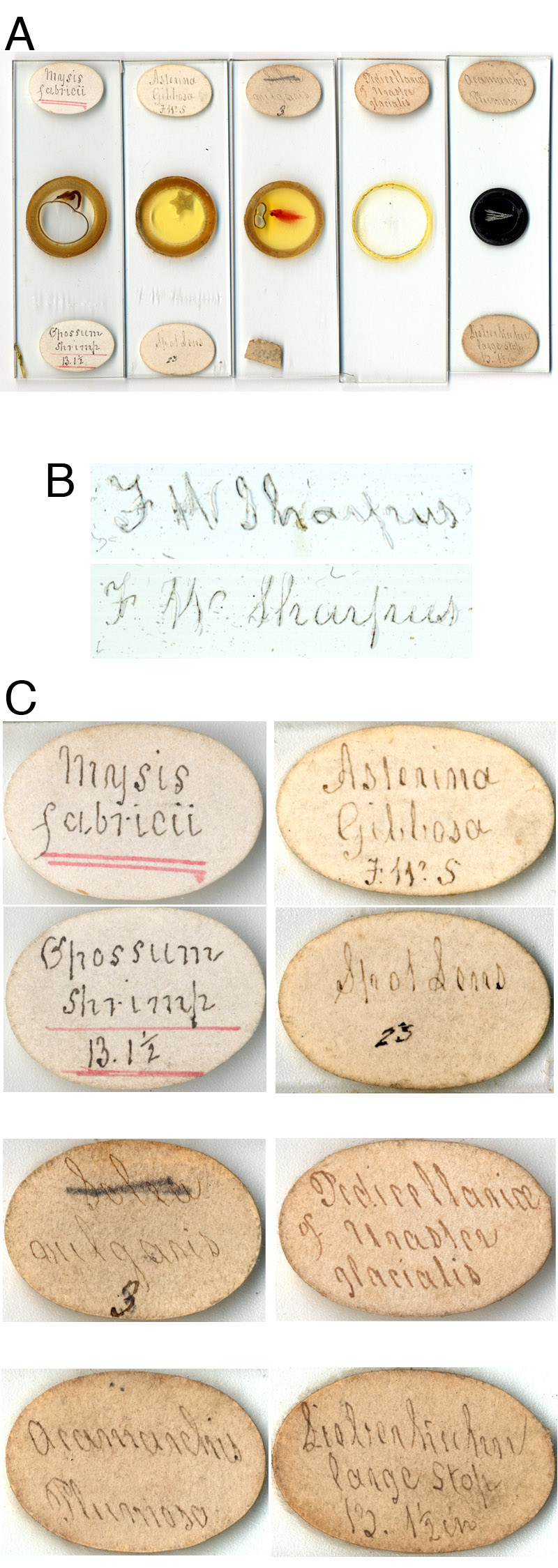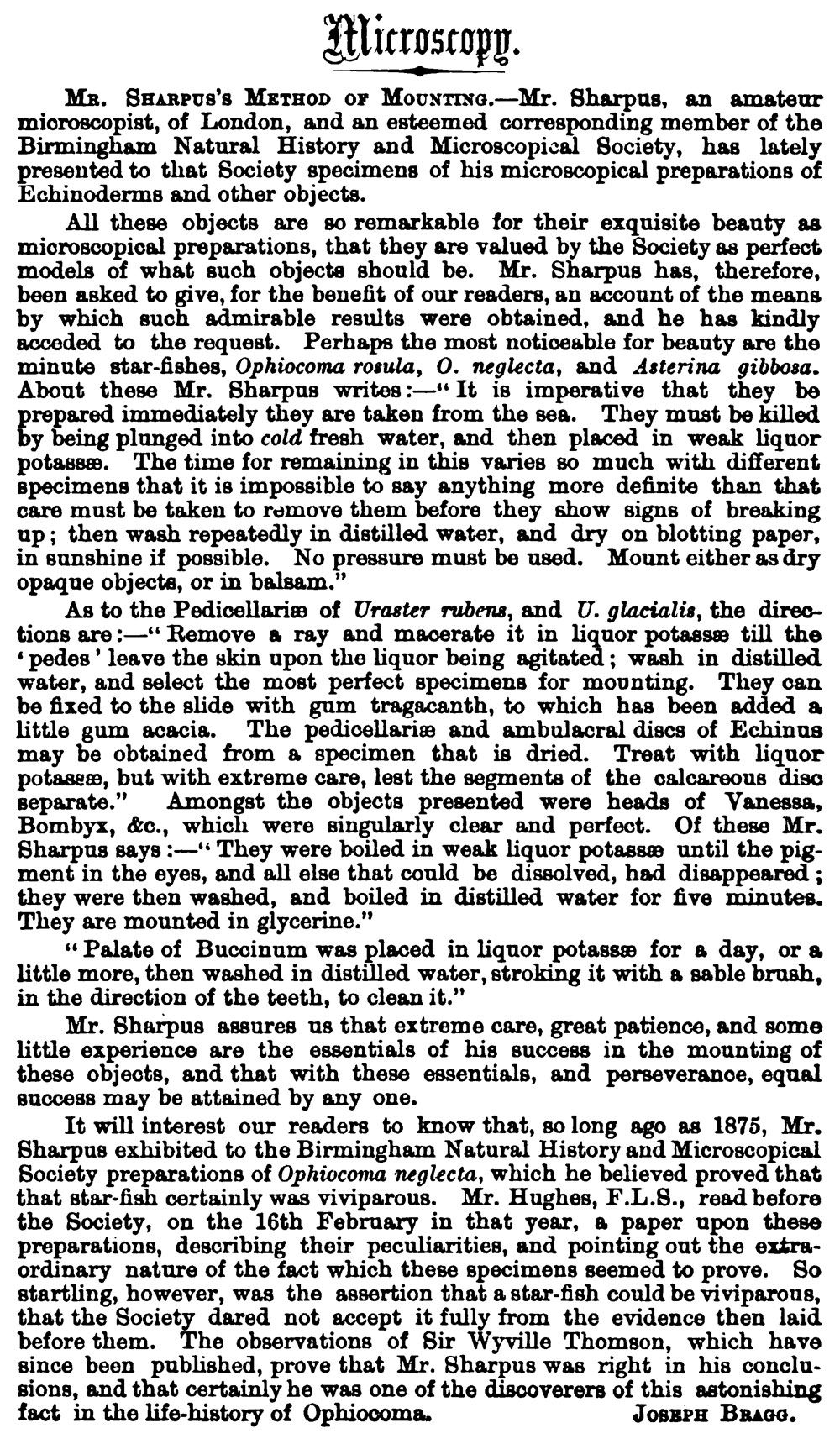Frederick Wever Sharpus, 1812 - 1897
by Brian Stevenson
last updated september, 2010
Sharpus was an amateur naturalist who became adept at making
microscope slides, in particular, mounts of aquatic animals such as starfish
and sea urchins. As far as is known, he spent his entire life in the London
area, working as a merchant, manufacturer and landlord. He was a long-time
corresponding member of the Birmingham Natural History and Microscopical
Society and its later incarnation, the Birmingham Natural History and
Philosophical Society. I did not find any records of him being associated with
any London-area microscopical societies. Although I do not have access to all
records from the Birmingham Society, I was unable to locate any mentions of
Sharpus actually attending a meeting. Instead, William R. Hughes always
presented Sharpus’ slides at functions. Hughes was Treasurer of the City of
Birmingham, indicating that Sharpus was well connected. Some examples of
Sharpus’ work are shown in Figure 1.

Figure 1.
(A) Examples of microscope slides prepared by Frederick Sharpus. The specimens shown are all sea life, subjects for which Sharpus is best known. The left two slides have his name etched into the glass. Two of these slides match published descriptions of slides donated by Sharpus to the Birmingham Natural History and Microscopical Society: “Mysis fabrici”, donated November 27, 1883, and “curious and interesting pincer-like organs…of the Star-Fish (Uraster glacialis)…termed Pedicellaria”, donated November 1, 1880 (see below).
(B) Sharpus’ engraved name, magnified and contrast-enhanced. The handwriting is very similar to that on the labels, and is likely Sharpus’ signature. The autograph on the “Mysis fabrici - Opossum Shrimp” slide has a backward slant, as do the labels on many of Sharpus’ slides. (C) Magnified views of the slides’ labels, to illustrate Sharpus’ delicate handwriting and unique style. There are a number of similarities between Sharpus’ handwriting and that of the earlier professional slide makers known by the initials “J. & T.J.”, and confusion between the two makers’
works often occurs. However, side-by-side comparisons will reveal significant
differences in letter structure.
Frederick Wever Sharpus was born June 27, 1812, and christened July
26 at St. Martin in the Fields. He married Sarah Sandford in February, 1837.
There are no records of the couple having had any children. A niece named
Delphia Mauricio lived with the Sharpus couple at the times of the 1841 and
1851 censuses. The 1841 census recorded Frederick’s occupation as what appears
to be “China Man.” Neighbors included
a printer, fishmongers, and merchants, so his job may have been merchant of
chinaware. The 1851 census unambiguously recorded his as “merchant”. The 1861 census recorded Frederick as being a “proprietor of houses”, and in 1871 he
was living off “houses & dividends”.
A servant lived at the house in 1841 and 1881, but not in 1851, ’61 or ’71. In 1881,
Sharpus was described as a “ribbon manufacturer” - based upon his previous
occupations and his connection to wealthy men such as W.R. Hughes, it is
reasonable to assume that Sharpus owned the ribbon factory. Sarah died during
the winter of 1891, and Frederick followed 6 years later, during the winter of
1897.
The earliest printed record I found of Frederick Sharpus, microscopist,
came from the 1878 Annual Report of the Birmingham
Natural History and Microscopical Society. This journal evolved the next
year into The Midland Naturalist. At
the 1878 Annual Meeting, “Mr. W. R.
Hughes exhibited, on behalf of Mr. F. W. Sharpus, a mounted specimen of
Ophiocoma, with six rays instead of five, and a series of microscopic slides of
marine objects, beautifully mounted, and accompanied with full directions as to
the mode of preparation. This series Mr. Hughes, on behalf of Mr. Sharpus, presented
to the Society”. Ophiocoma is a starfish, the brittle star.
The 1879 Midland Naturalist included a report of
“Mr. Sharpus’s Method of Mounting”,
reproduced below as Figure 2. This is of interest both as a historical document
and as a source of information on mounting for modern slide makers.
The 1878 Conversazione of the Birmingham Natural History and Microscopical Society included specimens from Sharpus: “Mr. W. R. Hughes, numerous specimens of echinodermata and other objects illustrating marine zoology, prepared by Mr. Sharpus, of London”. Several other notable microscopists displayed that night: “Mr. Washington Teasdale (Leeds) exhibited some very fine specimens of ruled patterns on glass, also sections of Nerium oleander, showing cellular tissue breaking through cortical layer to form a leaf-bud . . . Mr. Thos. Bolton, two microscopes, with a large selection of living objects, rotifers, diatoms, &c., and revolving table, with slate top, for microscopical purposes . . . Mr. E. Wheeler, of London, 1,000 microscopical preparations, no two alike, including Nobert’s lines, Moller’s typen-platten, with three microscopes . . . Rev. J. E. Vize, microscope and slides of hepaticae, fungi, lichens, mosses, &c.
In 1880, “Mr. W. R. Hughes, F.L.S., presented for the
cabinet of the Society, on behalf of Mr. F. W. Sharpus, of
London, one of the corresponding members, a series
of twelve slides, prepared by the donor, illustrating the structure and
functions of certain members of the class Echinodermata (Star-Fishes, Sea-Urchins,
etc.) They consisted of four slides demonstrating the viviparous nature of
Ophiocoma neglecta, one of the brittle-stars. Mr. Sharpus, who was the first
English observer who noticed this remarkable phenomenon, communicated the fact
to this Society some years ago. Four slides exhibiting the structure and
central apparatus of Ophiocoma roaula (another of the brittle -stars); one
Slide exhibiting the renewal of a lost leg in an extremely young specimen of
Uraster rubens (the common Cross-Fish), about one-third of an inch in diameter; and two slides showing the structure of certain curious and interesting
pincer-like organs, probably modified spines, of the Star-Fish (Uraster
glacialis), and of the Sea-Urchin (Echinus sphaera), termed Pedicellaria, the
functions of which have long been an unsolved problem to Zoologists, who are
not even now quite agreed as to their exact nature. In submitting the
preparations, Mr. Hughes glanced at the position of the Echinodermata as a
class, and particularly at the two methods of reproduction, one by means of a
pseudoembryo, and the other viviparously, as noticed by
Mr. Sharpus, supplemented in some instances, as was shown in the Challenger
expedition by means of a Marsupium. He also described the preparations
at length, which are extremely beautiful, the method of mounting which Mr.
Sharpus has by long experience as an amateur perfected, and which has already
been described in the Midland Naturalist, Vol. II., p. 126. The
preparations were further illustrated by drawings made by Mr. W. P. Marshall
and Mr. A. W. Wills. Mr. Levick superintended the microscopical exhibition. A
cordial vote of thanks was passed to Mr. Sharpus for his kind and valuable
present”.
In 1882, “Mr. W. R. Hughes,
F.L.S., then exhibited and presented to the Society six slides of Echinodermata
and Entozoa, on behalf of Mr. F. W. Sharpus, of London, by whom they were mounted. He also gave a description of
the slides and the points of interest which they illustrated. The first was a
young individual of Echinus sphaera, the common egg urchin, measuring only one
inch across, including the spines, mounted whole in such a manner that the
student could examine the whole external anatomy in detail on either the upper
or under surface. The second and third slides showed certain plates relating to
the ambulacral and pore systems, and formed very beautiful objects. The fourth
slide contained one of the arms of Ophiocoma rosula, the rosy brittle star,
complete to the very base. This is very difficult to obtain; everyone, who has attempted to catch these brittle
stars knows the facility with which they dismember themselves at the slightest provocation. The fifth and sixth
slides contained perfectly mounted specimens of the liver-fluke, Fasciola
hepaitica, in which the whole internal anatomy of these parasites could be
observed. . Mr. Sharpus's slides are deposited in the Society's cabinet, and can
be inspected by anyone who desires to see them”.
Other
donations to the Birmingham society, always through W.R. Hughes, included “a series of slides …
illustrating the development, structure, etc., of the Cephalopoda” (1882),
“Mysis Fabricii” (1883, see Figure 1,
above), “a slide mounted by Mr. Sharpus showing fossil Diatoms,
Infusoria, &c, contained in Kieselguhr” (1883), “the head of Vanessa urticae (smaller tortoiseshell butterfly), and a
very young specimen of Hippocampus brevirostris (the sea horse), showing the
gill tufts” (1883), and “a series
of twelve slides showing the anatomy of the spiders, including specimens from
Australia, South Africa, &c.” (1887). On June 10, 1884,
Sharpus presented, via Hughes, “six slides illustrating the larval stages in the development of the
Echinodermata (Echinopoedium, etc.) prepared by the students of the Zoological
Station at the Naples Aquarium”.
Frederick Sharpus was also a long-time supporter of the Ray Society, a
scientific publishing organization. He donated toward the cost of publishing
numerous books throughout his lifetime.

Figure 2. Tips on microscope slide preparing, from The Midland Naturalist,
Volume 2, page 126, 1879.
Resources
Birmingham
Natural History and Microscopical Society, Annual Report and List of Members
for the year 1878, pages 26-31 and List of Members
Bragg, Joseph (1879) Mr. Sharpus’s method of mounting, The Midland Naturalist, Vol. 2, page 126
Buckler, William (1901) The Larvae of the British Butterflies and Moths,
Volume 9, published by the Ray Society, Issue 77
Cameron, Peter (1885) A Monograph of the British Phytophagous Hymenoptera, Volume 2, published by the Ray Society
England vital statistics, including birth, marriage, death
and census records, accessed through ancestery.co.uk and familysearch.org
Journal
of the Birmingham Natural History and Philosophical Society (1894) List of members, Vol. 1, page 14
Marriage record of Frederick Wever Sharpus and Sarah Sandford
(1837) St. James Clerkenwell
The Midland Naturalist (1879)
The Conversazione, Vol. 2, page 171
The Midland Naturalist (1880)
Reports of Societies, Vol. 3, page 286
The Midland Naturalist (1881)
Annual Conversazione, Vol. 4, page 286
The Midland Naturalist (1883)
Reports of Societies, Vol. 6, pages 66-67 and 262>
The Midland Naturalist (1883)
Reports of Societies, Vol. 7, page 26
The Midland Naturalist (1884)
Reports of Societies, Vol. 7, pages 207, 288 and 330
The Midland Naturalist (1887)
Reports of Societies, Vol. 10, page 60

